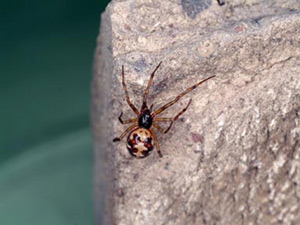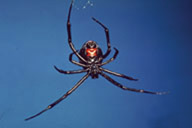Arachnids:
Creepy or Cool?
By Kathy Reshetiloff

Last year I spent 5 months hiking the Appalachian Trail. During that time I, of course, camped out in the woods and fields along the way. My house had been pretty much closed up during that time so I when I returned home I wasn’t prepared for what awaited for me.
Spiders! Everywhere. On the deck, in the house, in the shed, in the compost bin, even in my car. I saw more spiders that first day at home then I had seen on my entire hike along the trail.
Over the years I’ve become accustomed to the small spiders. I usually leave them alone or just pluck them away. It’s just the big ones, like the wolf spider I found in my compost bin, that make my skin crawl.
Despite my irrational fears, I left them alone. Most spiders are shy and harmless to people. They will not bite you unless they are trapped or held. And of course, spiders feed on many kinds of insects. They are important in controlling many pest insects in gardens or, in my case, my house.
Spiders are not insects but belong to group called arachnids. Spiders have eight legs, and lack wings and antennae. They have two body parts: a cephalothorax which is a head fused with a thorax and an abdomen. Most spiders have eight eyes and all have a pair of claw-like fangs through which venom can be ejected. Some make webs; others such as wolf spiders actively pursue their prey.
The tip of the abdomen has silk-spinning glands. The silk is secreted as a liquid that hardens on contact with air. Different types and textures of silk may be used to construct snares or webs, egg sacs, draglines and ballooning threads. Some spiders use web snares to trap prey, and all species construct a silk sac to deposit eggs.
Spiders lay eggs in a silken egg sac, often ball-shaped and hidden in the web or carried by the female. One female may produce as many as 3,000 eggs in a series of several sacs. Eggs may hatch a few weeks later (or the following spring). Spiders mature in one year. For a spider to grow, it must shed its skin (molt) usually four to twelve times. Most spiders live either one to two seasons. Here are a few common spiders in our area:
American House Spider
These are small spiders, usually yellow to brown with irregular markings. They build irregular webs in areas where insects fly or rest, usually in corners of rooms or windows. Cleaning or dusting in these areas is usually sufficient to control these spiders (well now I know why I have so of these in my house).
Garden Spider
One common outdoor spider is the black and yellow garden spider. It makes an elaborate and beautiful wheel-like web in shrubs and tall outdoor plants. They have poor vision and locate the prey by feeling the vibration in their web as insects are trapped. Despite their size, these spiders are not dangerous, but can bite if handled.
Wolf Spiders
Wolf spiders are active hunters and do not construct webs. Some can be fairly large and have a frightening appearance. They will not attack people unless their handled or confined. The bite is not dangerous but can be a very sharp bite. Wolf spiders come indoors most frequently in the fall and are usually found in basements. Exclusion is the best way to keep them outdoors.

Black Widow Spider
Not often found indoors the black widow spider is common to our area. The female is about 1⁄2 inch long, jet black with a bright red hour glass shape on the belly. This red mark is easily seen because she hangs upside down in the web. It is poisonous and more dangerous to children than adults. The black widow is not aggressive but will bite when touched. Should you be bitten, go to a doctor immediately for treatment
Often found in basement window wells, beneath benches or porches, in garages and sheds, and wood piles, this spider can be cleaned out of an area simply by knocking the webs, spiders, and round, tan egg sacs down with a stick and crushing them under foot.
Not everyone can live with even the most harmless arachnids in their home. But killing them should be avoided, if possible. Spiders enter homes through screens, around windows, doors and cracks. Maintaining tight fitting screens, weather stripping and sealing cracks can help prevent spider entry into the home. Regular dusting and vacuuming helps controls those already in your home (yeah, I know).
Back
|

